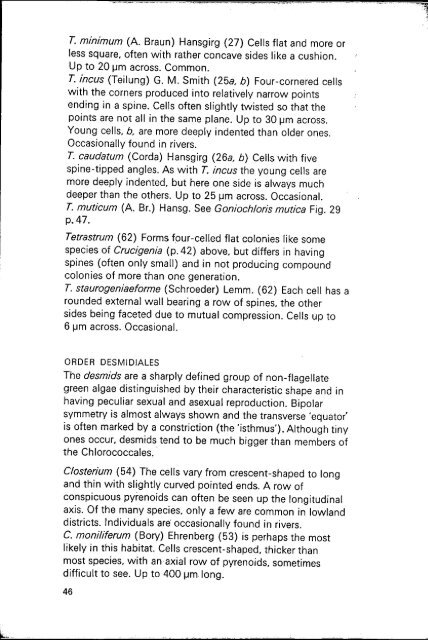Download (2189Kb) - NERC Open Research Archive - Natural ...
Download (2189Kb) - NERC Open Research Archive - Natural ...
Download (2189Kb) - NERC Open Research Archive - Natural ...
Create successful ePaper yourself
Turn your PDF publications into a flip-book with our unique Google optimized e-Paper software.
T. minimum (A. Braun) Hansgirg (27) Cells flat and more or<br />
less square, often with rather concave sides like a cushion.<br />
Up to 20 pm across. Common.<br />
T. incus (Teilung) G. M. Smith (25a, b) Four-cornered cells<br />
with the corners produced into relatively narrow points<br />
ending in a spine. Cells often slightly twisted so that the<br />
points are not all in the same plane. Up to 30 pm across.<br />
Young cells, b, are more deeply indented than older ones.<br />
Occasionally found in rivers.<br />
T. caudatum (Corda) Hansgirg (26a, b) Cells with five<br />
spine-tipped angles. As with T. incus the young cells are<br />
more deeply indented, but here one side is always much<br />
deeper than the others. Up to 25 pm across. Occasional.<br />
T. muticum (A. Br.) Hansg. See Goniochloris mutica Fig. 29<br />
p. 47.<br />
Tetrastrum (62) Forms four-celled flat colonies like some<br />
species of Crucigenia (p.42) above, but differs in having<br />
spines (often only small) and in not producing compound<br />
colonies of more than one generation.<br />
T. staurogeniaeforme (Schroeder) Lemm. (62) Each cell has a<br />
rounded external wall bearing a row of spines, the other<br />
sides being faceted due to mutual compression. Cells up to<br />
6 pm across. Occasional.<br />
ORDER DESMIDIALES<br />
The desmids are a sharply defined group of non-flagellate<br />
green algae distinguished by their characteristic shape and in<br />
having peculiar sexual and asexual reproduction. Bipolar<br />
symmetry is almost always shown and the transverse 'equator'<br />
is often marked by a constriction (the 'isthmus'). Although tiny<br />
ones occur, desmids tend to be much bigger than members of<br />
the Chlorococcales.<br />
Closterium (54) The cells vary from crescent-shaped to long<br />
and thin with slightly curved pointed ends. A row of<br />
conspicuous pyrenoids can often be seen up the longitudinal<br />
axis. Of the many species, only a few are common in lowland<br />
districts. Individuals are occasionally found in rivers.<br />
C. moniliferum (Bory) Ehrenberg (53) is perhaps the most<br />
likely in this habitat. Cells crescent-shaped, thicker than<br />
most species, with an axial row of pyrenoids, sometimes<br />
difficult to see. Up to 400 pm long.<br />
46

















